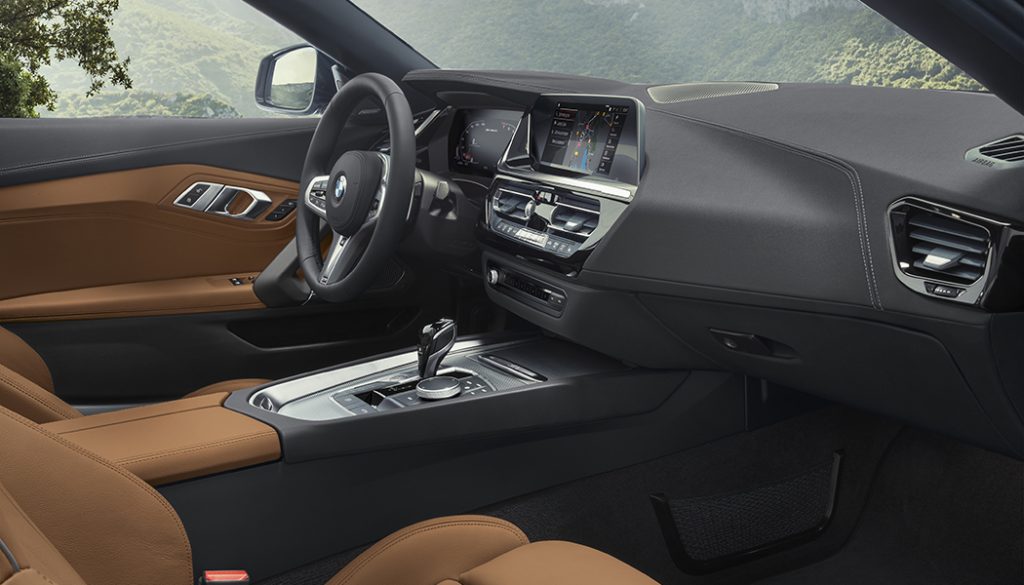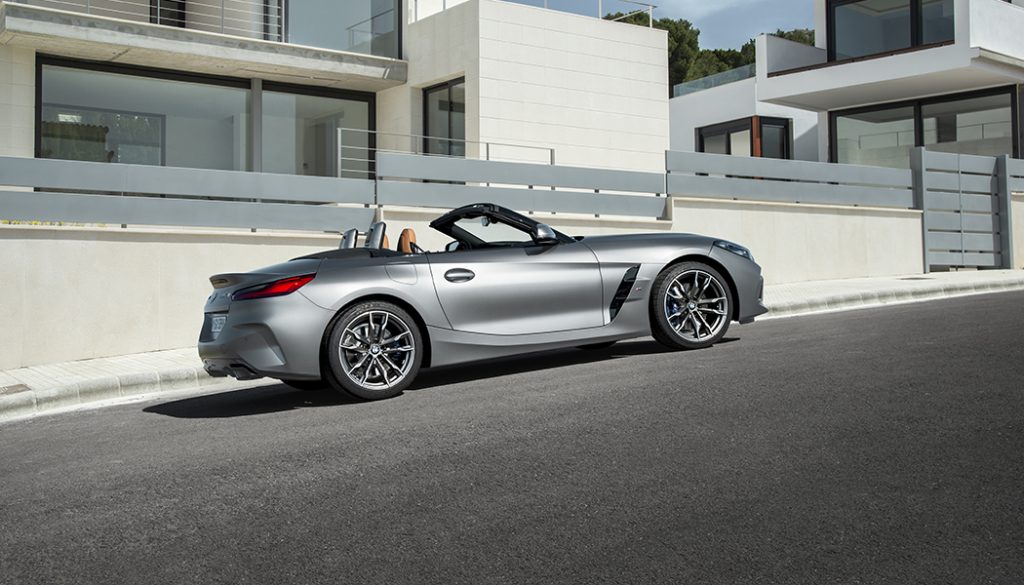Test Drive: 2020 BMW Z4 M40i
The latest version of the BMW Z4 is called the M40i. It gets a 3-litre straight-six turbo engine with the better part of 400 horsepower, targeted performance upgrades, an 8-speed automatic with paddle-shift, and rear-wheel drive. The motorized convertible top also takes a hike in about 10 seconds at the push of a button. In some ways, the 2020 BMW Z4 M40i is a lightweight hot-rod that’s probably nobody’s first choice for use in extreme winter weather—until you’ve tried it.
Cars like this have several things going for them when the going gets frigid and slippery.
First? A two-seat convertible is warmer in the winter with its top down than you probably think. In motion, an aerodynamic ‘bubble’ works to trap warm air into the car. It gets a bit nippy when you’re stopped at a light—but if you’re moving, even at sub-zero temperatures, blast the heater and you’ll do just fine with a light coat and a toque. If you’re ok with the funny looks at traffic lights, there’s little reason not to enjoy a top-down cruise on a warm January day.
Second? Many of the features and hardware that make a high-performing car like this one so track-day capable also make it great to drive in the snow.
For instance, the weight balance.
With half the 2020 BMW Z4’s mass over one axle and half over the other, it’s not tail-happy, front-heavy, or light in the rear. Both ends of the car weigh the same—meaning added stability and balance during high-speed race-track driving, but also, a tendency for the car to naturally want to travel in a straight line when operated carefully in deep snow. Translation? Driven appropriately for the conditions, the Z4 makes few sudden or surprising moves, and responds predictably.

Traction, Assisted
There’s also the M-Sport differential.
Bolted between the rear wheels, it features an internal computer-controlled mechanism that can actively control when, and how hard, the rear wheels are mechanically locked to one another. On bare pavement, this helps with maximum off-the-line acceleration and easier powering out of corners.
On snow and ice? Same deal. From a dead stop on something
slippery, this bit of track-inspired hardware means that both rear wheels
participate in propulsion, from the very first rotation.
On Blizzak tires, this saw your writer face minimal problems with traction,
even after heavy snowfall. Sure: AWD is better for getting quickly off the
line, but with proper winter boots and that trick diff, most will be surprised
at the available bite.
There are electronic aids, too.
Stability control considers the driver’s intended course against the vehicle’s current position, triggering a rapid sequence of individual-wheel braking that aims to correct the car’s attitude if needed. On snow and ice, this means drivers have an electronic guardian angel that works with their safe driving to keep the car properly behaved and in line. Or, set the system to its SPORT mode, and the system dials down a few notches, allowing safe and controlled powerslides in the hands of an adept driver.
Traction control limits how much wheelspin is permitted during straight-line acceleration. The system allows just enough wheelspin for the winter tires to fling their treads clean and keep the vehicle in motion. Or, turn the traction control down (or off) if you wish to partake in some winter drifting.
In the past decade or so, these systems have improved and become faster-acting, more effective, less intrusive, and almost totally seamless provided the driver keeps the laws of physics and winter driving in mind.
Add in drive-modes that further fine-tune things like steering feel and throttle response, and you can toggle the exact feel and personality you’d like your 2020 BMW Z4 to have, with a button press. The difference in vehicle attitude between each mode is substantial.
Smooth When Slippery
Driving in a snowstorm? Use COMFORT mode, where the car responds more smoothly and gently to your inputs, making it easier to drive the car carefully. Fancy a sideways romp down your favourite snowy backroad? Use the SPORT setting for the drive mode, and traction control, and have at it.
Do so, and you see some of the Z4’s best work.
The steering is quick and heavy—just like a go-kart. If you’re motoring hard, you grin at how little work is required at the wheel or throttle or brakes to point the car from one bend to the next. Pushed, little inputs cause big reactions from the 2020 BMW Z4, all with little touches on the steering, brakes or throttle. Get into its sporty groove, and the Z4 dances beneath you, responds predictably, and immediately, and feels confident and lively. Grins come quickly, one after the next.
And while much of the 2020 BMW Z4’s 382 horsepower will go unused when there’s snow passing underfoot, the stacks of low-end torque, combined with the burble-laden howl from the exhaust, provide immediate gratification to enthusiastic drivers.
Ditto the 8-speed automatic, which shifts cleanly and immediately in both directions, with immediate response from the paddle-shifters, when desired. Shifts are perfectly rev-matched in both directions, helping add further sporting appeal and entertainment value.
Downsides? Sure.
First, the Z4 is low, has a long nose, and outward visibility is limited. This requires extra care and attention when, say, emerging onto a roadway from behind a tall snowbank. I had no issues with ground clearance on my watch, though some of my mental bandwidth was spent being mindful of buried curbs, large highway slush-boulders, and deep snowbanks in my path. Finally, because the laws of physics are in full effect, drivers will need to use some forward thinking when stopping or setting off on a steep and snowy hill, to ensure they’ll be able to get moving again.
Two final thoughts that may prove useful if the 2020 BMW Z4 might be your first winter sports-car experience (or your first in a while).

Stay Cool Under Pressure
First, remember that a sports car is designed to give you an elevated sense of what’s happening between the tires and the road. It’s all about feedback and knowing what your car is up to at all times, which can help drivers make better decisions when the going gets greasy. In the best sports cars, you can feel black ice, slush ruts, and other changes in traction right through the steering. In this way, cars like the Z4 are feeding useful information to your fingers, helping you ‘feel’ what to do and what not to, and helping you to learn the best way to drive it for the conditions.
Second, because a sports car is typically designed to be as light as possible (and feel even lighter), there’s little false sense of security on slippery roads, which can arise if you’re driving something taller and heavier. And while most of us prefer to drive something taller and heavier in the colder months, there are still those who prefer something more nimble, lighter, more responsive, and more communicative.
If you’re one of them, you’ll do just fine in the new Z4. After all, driving your new convertible all year round provides a higher return on investment than storing it for half the year.






